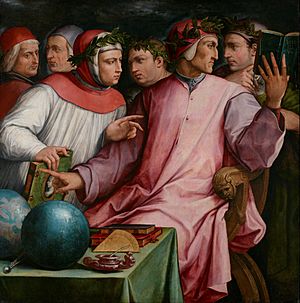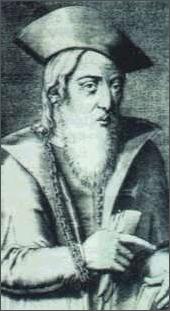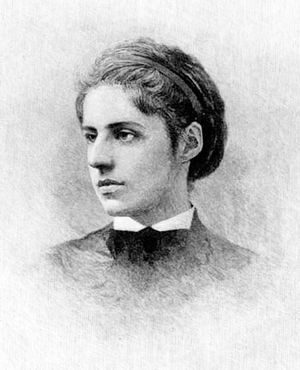Sonnet facts for kids
A sonnet is a special kind of poem. It always has 14 lines and uses a rhyme pattern. Think of it like a short story told in verse!
Contents
The Sonnet's Journey Through Time
The sonnet first appeared in Italy a long, long time ago, during the Middle Ages. It became very popular during the Renaissance, a time when art and learning blossomed. The first poet we know who wrote sonnets was Giacomo da Lentini in the 1200s. After him, many poets started writing them. Two famous Italian poets who wrote sonnets were Dante Alighieri and Guido Cavalcanti.
How Sonnets Spread Around the World
The Italian poet Petrarch became incredibly famous for his sonnets. Many other poets copied his style because he was so good! The sonnet form then traveled to other countries. Francisco de Sá de Miranda brought it to Portugal.
In England, Thomas Wyatt and Henry Howard, Earl of Surrey started writing sonnets. Even in faraway Poland, poets like Jan Kochanowski wrote them.
Famous Sonnet Writers
It became common for poets to write many sonnets linked together. These groups were called "sonnet sequences." They often told a story, like a love affair. Even Michelangelo, a famous sculptor and painter, wrote sonnets! He shared them with his friend Vittoria Colonna.
William Shakespeare wrote some of the most famous sonnets in English literature. Many other poets of his time, like Ben Jonson and Edmund Spenser, also wrote sonnet sequences. Later English poets, such as John Milton and William Wordsworth, continued to write sonnets that people still admire today. In the United States, Henry Wadsworth Longfellow and Emma Lazarus wrote sonnets.
Sonnets Today
The strict rhyme rules of the sonnet became less popular in the 1900s. However, some modern poets still write them. Edna St. Vincent Millay was one modern poet who often used the sonnet form. Today, poets sometimes change the traditional rhythms and rhyme patterns quite a bit.
Understanding Sonnet Structure
A sonnet always has 14 lines, but how those lines are grouped can be different. The two main types are the English (or Shakespearean) sonnet and the Italian (or Petrarchan) sonnet.
English (Shakespearean) Sonnet Structure
In a traditional "English" or "Shakespearean" sonnet, the first 12 lines are split into three groups. Each group has four lines and is called a "quatrain". The last two lines usually rhyme with each other. This rhyming pair is called a "rhymed couplet." This couplet often wraps up the poem by summarizing the story from the quatrains.
Italian (Petrarchan) Sonnet Structure
In a traditional "Italian" or "Petrarchan" sonnet, the poem is divided into two main parts. The first part has eight lines and is called an "octave." The second part has six lines and is called a "sestet."
Sonnet Rhyme Schemes
We use letters of the alphabet to show the rhyme pattern, or "rhyme scheme," of a sonnet. Each new letter means a new rhyming sound.
English Sonnet Rhyme Pattern
The typical rhyme scheme for an English sonnet is:
- a-b-a-b
- c-d-c-d
- e-f-e-f
- g-g
This means the first and third lines of the first quatrain rhyme (a), and the second and fourth lines rhyme (b). This pattern continues for the next two quatrains, and then the final two lines rhyme with each other (g-g).
Italian Sonnet Rhyme Pattern
The typical rhyme scheme for an Italian sonnet is:
- a-b-b-a
- a-b-b-a
- c-d-e-c-d-e
The first eight lines (the octave) usually follow the 'abba abba' pattern. The last six lines (the sestet) can have different rhyme patterns, like 'cdcdcd' or 'cddcdd'.
Other Sonnet Types
Another pattern is the Spenserian sonnet, created by Edmund Spenser. Its rhyme scheme is:
- a-b-a-b
- b-c-b-c
- c-d-c-d
- e-e
Crowns of Sonnets
Sometimes, sonnets can be linked together into a "crown of sonnets". In this special sequence, the very last line of the first sonnet becomes the first line of the second sonnet. This linking continues through the whole sequence. Sometimes, all these linking lines can even form another sonnet! The Slovenian poet France Prešeren is famous for his Wreath of Sonnets, which is a great example of a crown of sonnets.
Images for kids
See also
 In Spanish: Soneto para niños
In Spanish: Soneto para niños








